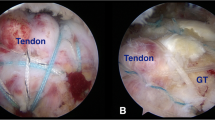Abstract
Purpose
The purpose of this study was to identify the relationship between an acromion index (AI) and the size of a rotator cuff tear. The hypothesis of our study was that an AI will be higher in patients with a full-thickness tear than in patients with a partial-thickness articular-side tear, and that it can be used as a predictor for the size of a rotator cuff tear.
Methods
We included 284 patients who had been diagnosed with rotator cuff tears and had undergone arthroscopic rotator cuff repair at our institute. All patients were divided into five distinct groups (partial-thickness articular side tear, and four subgroups of full-thickness tears) depending on the size of the rotator cuff tear on arthroscopy. In each patient, an AI was measured on the pre-operative oblique coronal MR images and then analysed to determine the difference between groups.
Results
There were statistically significant differences between the partial-thickness articular side rotator cuff tear and large-to-massive rotator cuff tear groups (p < 0.01), and the mean value of an AI was highest in the large-sized full-thickness tear group. The AI of the partial-thickness articular-side rotator cuff tear group was statistically different from the large-to-massive rotator cuff tear groups.
Conclusions
The AI can be a predictor which can differentiate a partial-thickness articular-side tear and a large-to-massive rotator cuff tear pre-operatively. However the AI could not provide useful guidance on predicting the differences in tear size in full-thickness tear patients. We suggest that a high AI can be one of the associated factors for progression to large-to-massive rotator cuff tears in a rotator cuff disease.





Similar content being viewed by others
References
Neer CS 2nd (1972) Anterior acromioplasty for the chronic impingement syndrome in the shoulder: a preliminary report. J Bone Joint Surg Am 54(1):41–50
Bigliani LU, Morrison DS, April EW (1986) The morphology of the acromion and its relationship to rotator cuff tears. Orthop Trans 10:228
Aoki M, Ishii S, Usui M (1986) The slope of the acromion and rotator cuff impingement. Orthop Trans 10:228
Banas MP, Miller RJ, Totterman S (1995) Relationship between the lateral acromion angle and rotator cuff disease. J Should Elbow Surg 4(6):454–461
Nyffeler RW, Werner CM, Sukthankar A, Schmid MR, Gerber C (2006) Association of a large lateral extension of the acromion with rotator cuff tears. J Bone Joint Surg Am 88(4):800–805. doi:10.2106/JBJS.D.03042
Torrens C, Lopez JM, Puente I, Caceres E (2007) The influence of the acromial coverage index in rotator cuff tears. J Should Elbow Surg 16(3):347–351. doi:10.1016/j.jse.2006.07.006
Zumstein MA, Jost B, Hempel J, Hodler J, Gerber C (2008) The clinical and structural long-term results of open repair of massive tears of the rotator cuff. J Bone Joint Surg Am 90(11):2423–2431. doi:10.2106/JBJS.G.00677
DeOrio JK, Cofield RH (1984) Results of a second attempt at surgical repair of a failed initial rotator-cuff repair. J Bone Joint Surg Am 66(4):563–567
Ozaki J, Fujimoto S, Nakagawa Y, Masuhara K, Tamai S (1988) Tears of the rotator cuff of the shoulder associated with pathological changes in the acromion. A study in cadavera. J Bone Joint Surg Am 70(8):1224–1230
Chansky HA, Iannotti JP (1991) The vascularity of the rotator cuff. Clin Sports Med 10(4):807–822
Nixon JE, DiStefano V (1975) Ruptures of the rotator cuff. Orthop Clin North Am 6(2):423–447
Bigliani LU, Ticker JB, Flatow EL, Soslowsky LJ, Mow VC (1991) Relationship of acromial architecture and diseases of the rotator cuff. Orthopade 20(5):302–309
Toivonen DA, Tuite MJ, Orwin JF (1995) Acromial structure and tears of the rotator cuff. J Should Elbow Surg 4(5):376–383
Hayes PR, Flatow EL (2002) Attrition sign in impingement syndrome. Arthroscopy 18(9):E44
Ouellette H, Labis J, Bredella M, Palmer WE, Sheah K, Torriani M (2008) Spectrum of shoulder injuries in the baseball pitcher. Skeletal Radiol 37(6):491–498. doi:10.1007/s00256-007-0389-0
Neer CS 2nd (1983) Impingement lesions. Clin Orthop Relat Res 173:70–77
Hirano M, Ide J, Takagi K (2002) Acromial shapes and extension of rotator cuff tears: magnetic resonance imaging evaluation. J Should Elbow Surg 11(6):576–578. doi:10.1067/mse.2002.127097
Nicholson GP, Goodman DA, Flatow EL, Bigliani LU (1996) The acromion: morphologic condition and age-related changes. A study of 420 scapulas. J Should Elbow Surg 5(1):1–11
Ogawa K, Yoshida A, Inokuchi W, Naniwa T (2005) Acromial spur: relationship to aging and morphologic changes in the rotator cuff. J Should Elbow Surg 14(6):591–598. doi:10.1016/j.jse.2005.03.007
Tucker TJ, Snyder SJ (2004) The keeled acromion: an aggressive acromial variant–a series of 20 patients with associated rotator cuff tears. Arthroscopy 20(7):744–753. doi:10.1016/j.arthro.2004.06.018
Dogan M, Cay N, Tosun O, Karaoglanoglu M, Bozkurt M (2011) Glenoid axis is not related with rotator cuff tears-a magnetic resonance imaging comparative study. Int Orthop. doi:10.1007/s00264-011-1356-x
Anderson K, Bowen MK (1999) Spur reformation after arthroscopic acromioplasty. Arthroscopy 15(7):788–791
Panni AS, Milano G, Lucania L, Fabbriciani C, Logroscino CA (1996) Histological analysis of the coracoacromial arch: correlation between age-related changes and rotator cuff tears. Arthroscopy 12(5):531–540
Bonsell S, Pearsall AWT, Heitman RJ, Helms CA, Major NM, Speer KP (2000) The relationship of age, gender, and degenerative changes observed on radiographs of the shoulder in asymptomatic individuals. J Bone Joint Surg Br 82(8):1135–1139
Kappe T, Cakir B, Lippacher S, Reichel H, Elsharkawi M (2011) Intraarticular lesions in calcifying tendinitis: incidence and association with the acromion index. Arch Orthop Trauma Surg 131(3):325–329. doi:10.1007/s00402-011-1263-z
Iannotti JP, Zlatkin MB, Esterhai JL, Kressel HY, Dalinka MK, Spindler KP (1991) Magnetic resonance imaging of the shoulder. Sensitivity, specificity, and predictive value. J Bone Joint Surg Am 73(1):17–29
Ko JY, Huang CC, Chen WJ, Chen CE, Chen SH, Wang CJ (2006) Pathogenesis of partial tear of the rotator cuff: a clinical and pathologic study. J Should Elbow Surg 15(3):271–278. doi:10.1016/j.jse.2005.10.013
Author information
Authors and Affiliations
Corresponding author
Rights and permissions
About this article
Cite this article
Kim, J.R., Ryu, K.J., Hong, I.T. et al. Can a high acromion index predict rotator cuff tears?. International Orthopaedics (SICOT) 36, 1019–1024 (2012). https://doi.org/10.1007/s00264-012-1499-4
Received:
Accepted:
Published:
Issue Date:
DOI: https://doi.org/10.1007/s00264-012-1499-4




